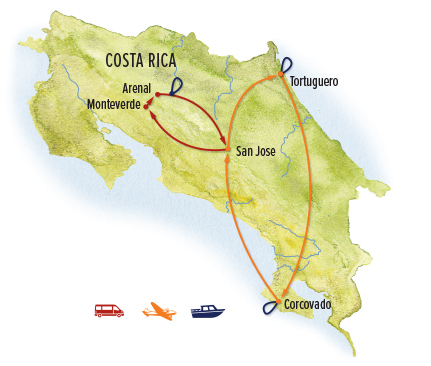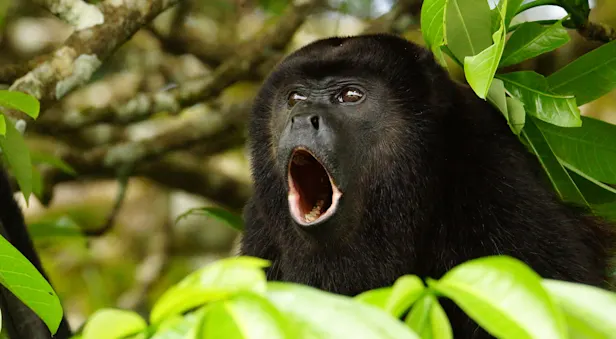Itinerary
Our Costa Rica adventure tour begins on arrival in the capital of San Jose, where you’re met at the airport and transferred to our luxury hacienda-style hotel. This evening, gather for a welcome dinner with our Expedition Leader.
Day 2: Tortuguero National Park—Private Boat Cruise
A private chartered flight takes us directly to Tortuguero, one of the best places to view wildlife in Costa Rica. From the airstrip, we’re quickly immersed in tropical wilderness as we board a boat to explore the mouth of the river, learning about the ecology of the lowland flooded rainforest as we follow a network of canals to Tortuguero village. Along the way, hear details of Tortuguero’s Indigenous origins, colonization and Afro-Caribbean heritage, and the establishment of the national park, including the impact of conservation and tourism on the local community today. Once we disembark, we head to our ecolodge to check in and have lunch.
Later this afternoon, another private boat cruise reveals plentiful wildlife as we navigate the maze of canals that lace the dense rainforest. We may see spider, howler and white-faced capuchin monkeys, tree sloths, caimans and a spectrum of colorful birds. Keep an eye out, too, for endangered green sea turtles if you are visiting from July to October.
Day 3: Tortuguero—Private Boat Cruise, Hike & Rainforest Night Walk
A dawn birding excursion is an option for early risers. Tortuguero is home to hundreds of different bird species including the endangered green macaw, Amazon kingfisher, toucans, egrets and herons. After breakfast, take a morning boat cruise through the canals. Here in the tropics, steady sunlight, constant rain and warm temperatures create an intense incubator for a profusion of species. Ocean and freshwater meet in Tortuguero’s network of lagoons, canals and beaches, creating an environment rich in biodiversity that's endlessly fascinating to explore. Traveling by boat allows us to cover a large swath of Tortuguero's rainforest, revealing fascinating microhabitats and varied wildlife not easily viewed on land.
This afternoon, join our Expedition Leader for an optional hike to a viewpoint high above the watery tropical wilderness below. A fully paved trail with stairs climbs some 350 feet to an overlook across the jungle laced with canals. Those who may not wish to hike can explore around the lodge on your own -- look for birds, wander nature trails on the property, or relax by the pool. After dinner, once darkness descends, take a guided night walk on the lodge grounds in search of nocturnal creatures, including some fascinating frogs.
Day 4: Osa Peninsula—Corcovado National Park
Our destination today is the remote Osa Peninsula at the southern end of Costa Rica's Pacific coast. Just getting there is an adventure, as we fly direct via private chartered plane to the peninsula and board 4x4 vehicles to reach the village of Agujitas on Drake Bay. Here, we board a boat and make a wet landing on the beach, then ride tractors up the hill to reach our accommodation for the next two nights, a luxury ecolodge on the edge of Corcovado National Park, the crown jewel of Costa Rica’s national park system. Corcovado Wilderness Lodge, surrounded by a 170-acre private reserve, offers convenient access to Corcovado National Park, which National Geographic has described as the “most biologically intense place on Earth.” Here among Costa Rica’s largest trees, we find Central America’s densest populations of scarlet macaws, tapir and the highly elusive jaguar. After lunch, walk the Sendero Azul, a short private trail on the lodge reserve. Woody vines, towering trees and walking palms line the way as we search for sloths, monkeys, agoutis, coatis and intriguing birdlife, including Baird’s trogon, spectacled owl and black-cheeked ant tanager.
Day 5: Exploring Corcovado National Park
Discover more of Corcovado's treasures on two nature walks today. As our long journey to reach this place attests, the Osa Peninsula is a wild and remote locale. It supports one of the world's most diverse lowland rainforests and is considered Costa Rica’s last wilderness frontier. Corcovado National Park, which covers 100,000 acres and one-third of the peninsula, includes at least 13 different ecosystems and protects a multitude of endemic wildlife and plant species. This biological diversity stronghold contains half of Costa Rica’s animal species, including scarlet macaw, toucans, parrots, all four monkey species found throughout the country, and jaguar, although these shy cats are rarely seen. On guided walks, look for the many fascinating creatures that reside in Corcovado's ancient forests.
Day 6: Corcovado / San Jose / Monteverde Cloud Forest
Return to Drake Bay airstrip via boat and 4x4 for our short chartered flight back to San Jose. Leaving the city behind, wind up twisting roads from coastal lowlands into the cool heights of Monteverde, which means “green mountain." Moisture here doesn’t typically come from rain but rather from the constant mists that swathe the mountaintops, creating the cloud forest environment. Straddling the spine of Costa Rica’s continental divide, Monteverde Cloud Forest Reserve supports 2.5% of worldwide biodiversity, including 100 mammal species and 161 different amphibians and reptiles. Many of these are indicator species, which means they are sensitive to environmental changes and can alert us when an ecosystem is threatened. Some of these unique creatures are found only in the high mountains of Costa Rica and neighboring Panama.
Our secluded ecolodge offers the ideal base for exploring, surrounded by lush gardens, dense forest and the melodious calls of birds in the canopy—more than 400 species flourish here, including the rare three-wattled bellbird. Just four populations of this Central American endemic remain, one of which is found in this area. Our Expedition Leader gives a talk on conservation, restoration and reforestation of the Pacific slope habitats of this bird known for its distinctive chiming call. Other highland endemics include the umbrella bird, emerald toucanets, and the resplendent quetzal, the iridescent bird sacred to the Indigenous people of these remote mountains.
Day 7: Monteverde—Canopy Skywalk / Curi-Cancha Reserve
Monteverde is the most studied montane cloud forest environment in the world, and one of the world's most threatened ecosystems. Nurtured by perpetual mists, it harbors an estimated 3,200 species of plants including giant strangler figs, a profusion of epiphytes that drape the forest from canopy to floor, and 500 different orchid species. As we explore the forest, look for wild relatives of many familiar houseplants such as philodendrons, bromeliads, ficus and ferns, and spot colorful butterflies flitting among the leaves.
We get a different view of the intricate web of life on display via the Skywalk, a 1.5-mile network of elevated walkways that lift us into the canopy. About 90% of all organisms in the cloud forest live in the treetops, which the sun strikes to produce abundant food. Later this afternoon, explore the Curi-Cancha Reserve, a private sanctuary frequented by a great variety of birds, including the resplendent quetzal and bellbird. Curi-Cancha is 50% virgin forest, with most of the remainder restored to native forest from pastureland in recent decades. Mammal sightings may include agouti, coati, armadillo, kinkajou, ocelot, sloth, olingo, porcupine and three species of monkey: mantled howler, white-faced capuchin and spider monkey. Sometimes, if we are more likely to see quetzals in the nearby Monteverde Cloud Forest Reserve, we may substitute a visit here in lieu of Curi-Cancha, with similar wildlife sightings possible.
Day 8: Lake Arenal Private Cruise / Arenal Volcano Lodge—Rainforest Night Walk
Leaving Monteverde early this morning, we drive around the vast expanse of Lake Arenal, enjoying stunning views en route. A private boat cruise on the lake offers an expansive vista of Arenal Volcano. Continue to Arenal Observatory Lodge, set high on a ridge facing the famous volcano, surrounded by thousands of acres of tropical rainforest. Seismologists from the Smithsonian Institution and the National University of Costa Rica closely monitor the volcano from the research station at the lodge. Until 2010, minor eruptions had been constant, with the symmetrical cone spewing magma and smoke on an almost daily basis. Since then, the 5,437-foot volcano has been in a dormant phase, though still simmering inside. A new volcano visitors center contains extensive photos and data on the history of Arenal.
Built in 1987 originally as a scientific research station for the Smithsonian, the lodge is the only accommodation inside Arenal National Park, with 15 miles of private trails in the rainforest foothills that surround it. Nearly 500 bird species are found on the premises, one of the most extensive lists in the American tropics. Flowers and fruiting trees in the garden in front of the lodge attract constant bird activity, with 30+ species of hummingbird on display. Mammals are abundant, too, and we could spot spider monkeys, howler monkeys, coati, brocket deer, anteater and peccary. Infrequently seen but also present are wild cats, such as puma, jaguar, ocelot and oncilla. Our Expedition Leader offers an introduction to our environs, revealing myriad secrets of the forest on a nature walk. After dark, a guided night walk reveals nocturnal wildlife, including the famous frog pond with its noisy chorus of croaks and clicks.
Day 9: Arenal Nature Reserve—Guided Walking Tours
Explore the rainforest on morning and afternoon walks on the vast network of trails radiating from Arenal Observatory Lodge. The grounds, laced with rivers and waterfalls, include nearly 700 acres of primary rainforest and tropical gardens—one of the largest natural reserves in Costa Rica. Among the lush vegetation and colorful flowers we find both resident and migratory tropical birds, including a multitude of hummingbirds, and lively monkeys, including howler, spider and white-faced capuchin species. Other mammals are more rarely seen, but we might glimpse peccary, coati, margay or ocelot, plus sleepy sloths high in the branches. Our easy hikes include a walk to Danta Waterfall, a rushing cascade that tumbles 20 feet off a shaded precipice into a clear tropical pool below. Two hanging bridges give an eye-level perspective on the canopy and offer grand views of Arenal Volcano.
Day 10: Nature Walk / Canopy Tower / Observatory Museum
This morning, discover more wonders of the rainforest on a guided walk from the lodge, and get a bird’s eye view over the canopy from The Nest, a 92-feet-high observation tower in the heart of the tropical forest. During the climb to the top, keep an eye out for monkeys, toucans and other animals moving through the lower levels of the trees. Once at the top, you are rewarded with a 360° panorama of Arenal Volcano, Arenal Lake, Cerro Chato Volcano and the Tilaran Mountains.
At the Observatory Visitor Center, tour the museum to learn about the natural history of the Arenal region, the dam creating Lake Arenal, and volcanology research conducted here since the early 1970s. This modern-day lodge got its start as a research station for scientists who came to watch the dynamic volcano, which has been dormant since 2010. Among those conducting environmental studies have been volcanologists, botanists, biologists and geologists from the Smithsonian Institution, Earthwatch Institute, OVSICORI (Costa Rica Observatory of Volcanology and Seismology), and the University of California.
After lunch, your time is to hike on your own or with the group, with recommendations from our Expedition Leader, or just relax among the gardens and verdant grounds around our lodge. Reconvene at our lodge this evening for a special farewell dinner.
Day 11: San Jose / Depart
After a last breakfast in the shadow of Arenal Volcano, return by road to San Jose to connect with homeward flights. Please schedule flight departures no earlier than 1:30 pm today.




























